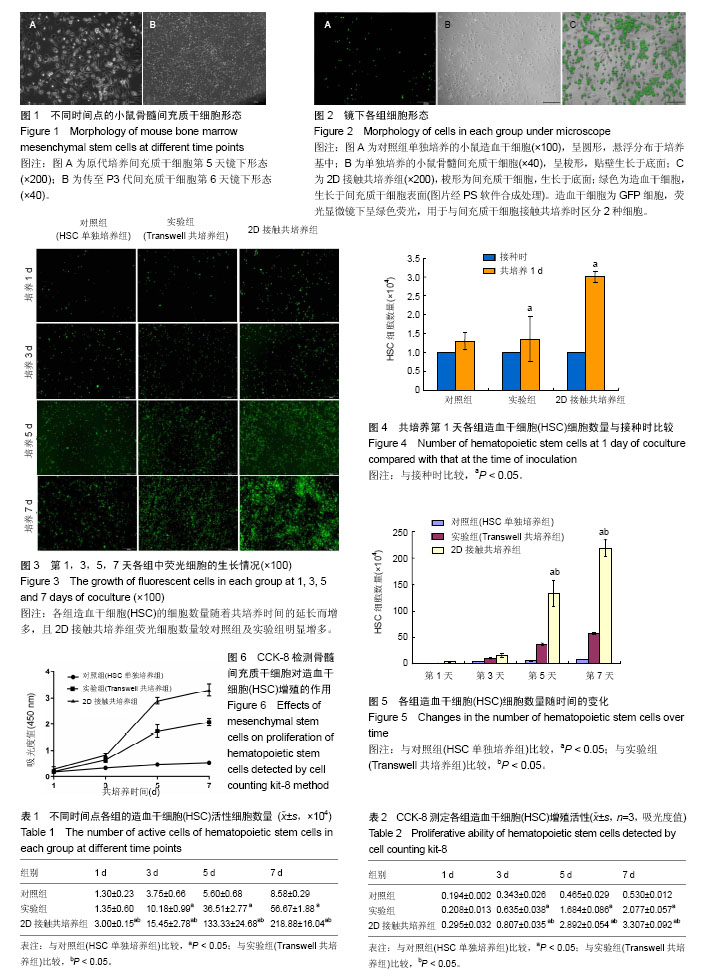| [1] Lucas D.The Bone Marrow Microenvironment for Hematopoietic Stem Cells.Adv Exp Med Biol. 2017;1041:5-18.[2] Le Blanc K, Frassoni F, Ball L, et al. Mesenchymal stem cells for treatment of steroid-resistant, severe, acute graft-versus-host disease: a phase II study.Lancet. 2008;371(9624):1579-1586.[3] Oostendorp RA, Robin C, Steinhoff C, et al. Long-term maintenance of hematopoietic stem cells does not require contact with embryo-derived stromal cells in cocultures.Stem Cells. 2005;23(6):842-851.[4] Baksh D, Davies JE, Zandstra PW. Soluble factor cross-talk between human bone marrow-derived hematopoietic and mesenchymal cells enhances in vitro CFU-F and CFU-O growth and reveals heterogeneity in the mesenchymal progenitor cell compartment. Blood.2005;106(9):3012-3019.[5] Wagner W, Wein F, Roderburg C, et al. Adhesion of human hematopoietic progenitor cells to mesenchymal stromal cells involves CD44. Cells Tissues Organs. 2008;188(1-2):160-169.[6] Calvi LM, Link DC.The hematopoietic stem cell niche in homeostasis and disease.Blood. 2015;126(22):2443-2451.[7] Morrison SJ, Scadden DT. The bone marrow niche for haematopoietic stem cells. Nature. 2014;505(7483):327-334.[8] Galán-Díez M, Kousteni S. The osteoblastic niche in hematopoiesis and hematological myeloid malignancies. Curr Mol Biol Rep. 2017;3(2):53-62.[9] Xue Y, Lv J, Zhang C, et al. The Vascular Niche Regulates Hematopoietic Stem and Progenitor Cell Lodgment and Expansion via klf6a-ccl25b. Dev Cell. 2017;42(4):349-362.e4.[10] Huang X, Cho S, Spangrude GJ. Hematopoietic stem cells: generation and self-renewal. Cell Death Differ. 2007;14(11): 1851-1859.[11] Kubota Y, Takubo K, Suda T. Bone marrow long label-retaining cells reside in the sinusoidal hypoxic niche. Biochem Biophys Res Commun.2008;366(2):335-339.[12] Kolf CM, Song L, Helm J, et al. Nascent osteoblast matrix inhibits osteogenesis of human mesenchymal stem cells in vitro. Stem Cell Res Ther. 2015;6:258.[13] Jiang Y, Jahagirdar BN, Reinhardt RL, et al. Pluripotency of mesenchymal stem cells derived from adult marrow. Nature. 2002;418(6893):41-49.[14] Majumdar MK, Thiede MA, Haynesworth SE, et al. Human marrow-derived mesenchymal stem cells (MSCs) express hematopoietic cytokines and support long-term hematopoiesis when differentiated toward stromal and osteogenic lineages. J Hematother Stem Cell Res. 2000;9(6):841-848.[15] Aggarwal S, Pittenger MF. Human mesenchymal stem cells modulate allogeneic immune cell responses. Blood, 2005, 105(4):1815-22.[16] 方洪松,周建林,彭昊,等. 不同来源间充质干细胞生物学特性差异[J]. 中国组织工程研究, 2015,19(32):5243-5248.[17] 解琳娜,健民,邱慧颖,等.小鼠间充质干细胞培养扩增后生物学特性研究[J]. 中国实验血液学杂志, 2007,(03):542-546.[18] 张荣耀,毕晓娟,马艳,等. 全骨髓法培养C57小鼠骨髓间充质干细胞的生物学特性[J]. 中国组织工程研究, 2014,18(1):45-50.[19] Cerisoli F, Cassinelli L, Lamorte G, et al. Green fluorescent protein transgene driven by Kit regulatory sequences is expressed in hematopoietic stem cells. Haematologica. 2009;94(3):318-325.[20] Sheikh BN, Yang Y, Schreuder J, et al. MOZ (KAT6A) is essential for the maintenance of classically defined adult hematopoietic stem cells. Blood. 2016;128(19):2307-2318.[21] Ruf F, Schreck C, Wagner A, et al. Loss of Sfrp2 in the Niche Amplifies Stress-Induced Cellular Responses, and Impairs the In Vivo Regeneration of the Hematopoietic Stem Cell Pool. Stem Cells.2016;34(9):2381-2392.[22] Selman C, Sinclair A, Pedroni SM, et al. Evidence that hematopoietic stem cell function is preserved during aging in long-lived S6K1 mutant mice. Oncotarget.2016;7(21): 29937-29943.[23] Okada S, Nakauchi H, Nagayoshi K, et al. In vivo and in vitro stem cell function of c-kit- and Sca-1-positive murine hematopoietic cells. Blood.1992;80(12):3044-3050.[24] Yang Y, Chen QH, Liu AR, et al. Synergism of MSC-secreted HGF and VEGF in stabilising endothelial barrier function upon lipopolysaccharide stimulation via the Rac1 pathway. Stem Cell Res Ther.2015;6:250.[25] Zavala G, Prieto CP, Villanueva AA, et al. Sonic hedgehog (SHH) signaling improves the angiogenic potential of Wharton's jelly-derived mesenchymal stem cells (WJ-MSC). Stem Cell Res Ther.2017;8(1):203.[26] Matsuoka Y, Nakatsuka R, Sumide K, et al. Prospectively Isolated Human Bone Marrow Cell-Derived MSCs Support Primitive Human CD34-Negative Hematopoietic Stem Cells. Stem Cells.2015;33(5):1554-1565.[27] Pontikoglou C, Deschaseaux F, Sensebé L, et al. Bone marrow mesenchymal stem cells: biological properties and their role in hematopoiesis and hematopoietic stem cell transplantation. Stem Cell Rev. 2011;7(3):569-589.[28] Overholt KM, Otsuru S, Olson TS, et al. Identification of a murine CD45-F4/80loHSC-derived marrow endosteal cell associated with donor stem cell engraftment. Blood Adv. 2017;1(27): 2667-2678.[29] Cao B, Zhang Z, Grassinger J, et al. Therapeutic targeting and rapid mobilization of endosteal HSC using a small molecule integrin antagonist. Nat Commun.2016;7:11007.[30] 尹利明,赵燕娜,杜文喜,等. 人参总皂苷增强成骨分化的间充质干细胞促造血作用研究[J]. 中国药理学通报, 2015,31(1):45-49.[31] da Silva CL, Gonçalves R, dos Santos F, et al. Dynamic cell-cell interactions between cord blood haematopoietic progenitors and the cellular niche are essential for the expansion of CD34+, CD34+CD38- and early lymphoid CD7+ cells. J Tissue Eng Regen Med. 2010;4(2):149-158.[32] Zhang Y, Chai C, Jiang XS, et al. Co-culture of umbilical cord blood CD34+ cells with human mesenchymal stem cells. Tissue Eng. 2006;12(8):2161-70.[33] Wagner W, Roderburg C, Wein F, et al. Molecular and secretory profiles of human mesenchymal stromal cells and their abilities to maintain primitive hematopoietic progenitors. Stem Cells.2007; 25(10):2638-47.[34] 梁雨蒙,王晓娜,邓磊,等. 骨髓间充质干细胞微泡生物学特性及其促进造血干细胞体外扩增作用的研究[J]. 中国实验血液学杂志, 2017,25(4):1187-1193.[35] Jing D, Fonseca AV, Alakel N, et al. Hematopoietic stem cells in co-culture with mesenchymal stromal cells--modeling the niche compartments in vitro. Haematologica.2010;95(4):542-550.[36] Freund D, Bauer N, Boxberger S, et al. Polarization of human hematopoietic progenitors during contact with multipotent mesenchymal stromal cells: effects on proliferation and clonogenicity. Stem Cells Dev. 2006;15(6):815-829.[37] 何梦娇,江俊,郑宝玉,等. 骨质疏松大鼠骨髓基质细胞膜片的体外构建研究[J]. 中国骨质疏松杂志, 2017,(8):996-1001.[38] 袁林,钱钧,杨征毅,等. 不同来源骨髓间充质干细胞成骨能力的比较[J]. 口腔疾病防治,2017,(9):554-559.[39] Ramirez F, Rifkin DB. Cell signaling events: a view from the matrix. Matrix Biol.2003;22(2):101-107.[40] Dao MA, Hashino K, Kato I, et al. Adhesion to fibronectin maintains regenerative capacity during ex vivo culture and transduction of human hematopoietic stem and progenitor cells. Blood.1998;92(12):4612-4621.[41] Keto J, Kaartinen T, Salmenniemi U, et al. Immunomonitoring of MSC-Treated GvHD Patients Reveals Only Moderate Potential for Response Prediction but Indicates Treatment Safety. Mol Ther Methods Clin Dev. 2018;9:109-118.[42] Resnick IB, Barkats C, Shapira MY, et al. Treatment of severe steroid resistant acute GVHD with mesenchymal stromal cells (MSC). Am J Blood Res.2013;3(3):225-238.[43] Fernández-García M, Luisa LM, Hernando-Rodríguez M, et al. Improved Hematopoietic Gene Therapy in a Mouse Model of Fanconi Anemia Mediated by Mesenchymal Stromal Cells. Hum Gene Ther. 2017 Oct 4. doi: 10.1089/hum.2017.076.[44] De Luca L, Trino S, Laurenzana I, et al. Mesenchymal Stem Cell Derived Extracellular Vesicles: A Role in Hematopoietic Transplantation. Int J Mol Sci, 2017,18(5). pii: E1022.[45] Martin I, Ireland H, Baldomero H, et al. The Survey on Cellular and Engineered Tissue Therapies in Europe in 2013. Tissue Eng Part A.2016;22(1-2):5-16. |
.jpg)

.jpg)